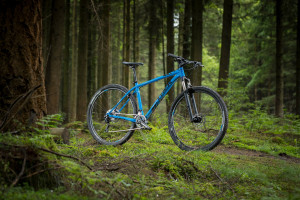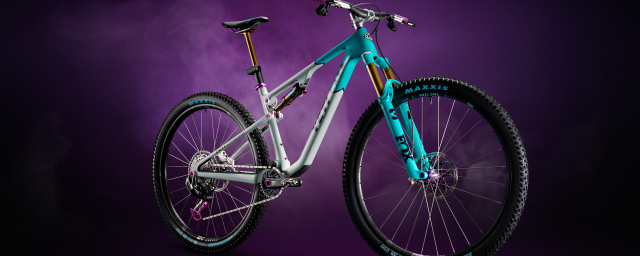The Vitus Rapide FS CR is a new cross-country focused bike, with the CR being the lower of two models in the range, retailing at £2,499. It delivers impressive performance with geometry that makes it fun and capable downhill while still being quick uphill. The component selection also helps to keep the overall weight competitive. There are a couple of components equipped that prevent it from being perfect. Still, it offers excellent value with performance a match for bikes twice the price.
- Cross-country racing: Where next for the UK?
- Will your next bike be a gravel bike?
- The complete buyer's guide to mountain bike handguards
Vitus Rapide FS CR: Frame & Suspension
The Vitus Rapide FS is built on a full carbon frame with 100mm of travel from the Rockshox SID Luxe Select+ rear shock. It's pleasing to see large cable entry ports in the frame for internal routing that makes cable routing easy when replacements are needed. Neither the CR nor the pricier CRX model (£3,299) features a dropper post as standard, but there is a free cable port to fit one in the future.
The only colour option for the CR is grey, or Burnt Nardo, as Vitus name it, and there is no claimed frame weight given, but the overall weight of the bike is 12.02kg (26.5lb), weighed set up tubeless. While this is not a super-light bike, it is competitive for the style and price. Compared to the Specialized Epic Comp tested earlier this year, which weighed 11.82kg (26.0lb) and retailed for £4,500.
The suspension performance on the rear is good generally on the downhills. Still, it feels too active while pedalling, even with more air in the shock at the lower recommended range of 20% sag for my weight. I feel the shock needs a more low-speed compression, given it is designed with at least one eye on racing. Pedal feedback gives a slower ride feel, and while bump response is good for smaller bumps, I would far rather have a shock with more low-speed compression damping to aid pedalling.
On descents, Rockshox SID Luxe Select+ rear shock offers good control on larger hits, rarely suffering from bottoming out despite the limited travel. One slight frustration is the location of the rebound adjuster, which requires a 2.5mm Allen key positioned in a way that needs the short end of a right-angled hex-key and is not possible with any multi-tool I had available. It was especially frustrating on earlier rides when attempting to tune in the setting to suit. You will likely be glad when it is done and hopefully not need to adjust often afterwards.
The saving grace to the issue with pedal bob is the Rockshox Onelock lever on the handlebar that locks the front fork and rear shock simultaneously with one push. The lever requires a little force to activate, almost certainly due to the friction within a two-cable setup. Still, I found myself using the lever more than on any other bike I have ridden. While that may be down to the overly active rear, having the ability to quickly lock the fork and shock simultaneously is very useful for racing or even faster trail riding. Unlocking requires very little force with the spring action of the lever, and it's located in a good position on the handlebars for easy access.
The medium size frame tested has a single water bottle mount using a 3-bolt fixing. The lack of a second water bottle cage might disappoint some racers, especially as there is potential to fit two cages on the downtube on a medium size.
The finishing on the bolt bosses is poor, with the thread slightly out of line. The bolts provided were too short to go through a water bottle cage and reach the threads. This is cheap and easy to fix, but a shame that it is needed at all. The only other potential issue on the frame is the cable routing around the shock, where the cables are in contact with the shock casing. Ultimately this will lead to wear, and I would strongly advise adding a thick layer of protection tape to the shock to prevent problems in the future.
The bottle bolt bosses and shock cable rub are the only real issue on the frame. There are many nice features, including a metal chainstay protection plate built into the frame to prevent damage in the event of chain-suck.
Tyre clearance is fair for a cross-country style bike with spare room around the 2.25” tyres fitted. I would suggest 2.35” or potentially 2.4” being possible in the rear. However, that would only be wise in dry weather as it will reduce the mud clearance.
The Rockshox suspension continues at the front also, with the SID Select Charger RL fork with 100mm travel. I am sure there will be some people wishing for a 120mm version, but in my experience, the fork belies the limited travel on offer, handling larger hits incredibly well. The fork was also very simple to set up, requiring minimum adjustment to reach a point where I felt happy.
Vitus Rapide FS CR: Geometry
The Rapide follows in the path of several other cross-country focused bikes, including the Specialized Epic and Scott Spark. These bikes share a more relaxed, progressive geometry with stats that include a 67º head angle on our medium bike, making it slightly slacker than most well-known competition models.
While this might aim to improve stability and handling on the descents, for a bike focusing on cross-country riding, this can not be at the detriment of flat or uphill riding. A 77º seat tube angle gives an upright feel to put the rider in a reasonably economical riding position. The position makes the lack of a dropper seatpost even more glaring. The addition of one would likely further enhance what is already a capable bike.
For riders who like a low, aggressive position at the front, Vitus provides a short head tube (105mm on our medium frame), 100mm travel fork and zero-stack headset allows for a very low riding position should you wish.
Vitus Rapide FS CR: Drivetrain & Brakes
The Shimano Deore 12-speed set makes up for most of the shifting components. The only exception is SLX rear derailleur, with a screw-fit bottom bracket that will please riders who dislike press-fit. Shifting is clean enough through most of the range, with only the larger gaps in the final few gear changes causing any slight lag.
Braking is supplied by Shimano Deore with 180mm rotors front, 160mm rear that suit the style of bike, and I found power more than enough.
Our test bike was fitted with a 30 tooth chainring, which is small for a race bike, and I found I was spinning out even on relatively easy sections. Despite taking on challenging routes and climbs, I don't think I used the largest 51 tooth cassette cog once. While I appreciate everyone is different and local trails vary substantially, as a bike designed for racing, there needs to be some emphasis on speed. I would question the selection of such a small chainring. Vitus doesn't give a maximum chainring size, but there appears to be clearance for 36 teeth.
Vitus Rapide FS CR: Components & Wheels
The finishing kit is mostly Vitus' own brand with a 60mm stem on our medium test bike, 740mm handlebar width and a rigid 400mm alloy seatpost.
Fitting a dropper seatpost would be a worthy addition. The bike feels extremely capable of geometry and suspension performance, giving more confidence downhill than many other cross-country bikes.
The DT Swiss X1900 wheels are a reasonable all-around set that offers a balance of weight and strength suited to the spec and price point. The rims on the X1900 wheels are tubeless-ready but quite narrow with a 25mm internal rim width. The wheelset is made with reliable and durable DT 370 hubs laced with straight-pull DT Champion spokes that are regarded as the workhorse of the DT range with a basic plain gauge design.
Cassette pickup on the hubs is good, thanks to the DT pawl-free ratchet drive system matching the Microspline 12-speed freehub body.
The tyres on the Rapide are Maxxis Recon Race 2.25", and it is good to see no shortcuts here with the TR (tubeless-ready) and EXO sidewall protection casing chosen. As we move into winter, the grip on muddier tracks is not great, but for drier weather and race use, the tyre is a popular choice with good all-round ability on various surfaces without feeling like you are towing a train.
Vitus Rapide FS CR: Value & Verdict
The Rapide FS scores highly on value as there is very little on the market that can compete. Specialized has the Epic Comp that we tested earlier this year which was a fantastic and fun bike to ride. Still, at £4,500, you pay a premium for it. The drivetrain is predominantly Shimano SLX, just a tier above the Rapide FS.
Canyon has the Lux CF6, which also features 100mm travel front and rear but more traditional geometry. It is also aimed at cross-country and marathon racing with the cheapest model at £2,999 equipped with an SLX drivetrain and the same DT Swiss X1900 wheels as on the Rapide. Within the new Scott Spark range, the cheapest model is the RC Comp at £3,299 with SRAM NX drivetrain and Fox suspension.
While the bike name might be declaring the intensions for speed, the Rapide CR is a bike that is surprising in how much fun it can be to ride. The more relaxed, progressive geometry works well with parts selected that, on the whole, deliver the intentions of the design. There are some part choices I don't like, such as the tiny 30 tooth chainring and a dropper post would improve things, but what can't be altered afterwards is the geometry. This forms the heart of the bike, being fun downhill while also keeping a low front end to make steep, technical climbs possible and rewarding.
The Vitus FS CR is a fun, fast bike to ride and even though it is significantly cheaper than some of the other short-travel full-suspension bikes tested recently, this would be my pick. For racers and riders who simply enjoy the challenge of long days in the saddle, it offers all-around performance and at a price that undercuts all major brands.





















Add comment